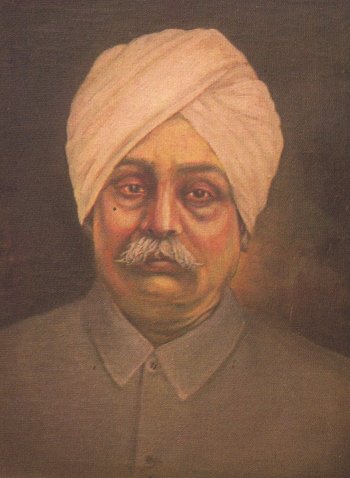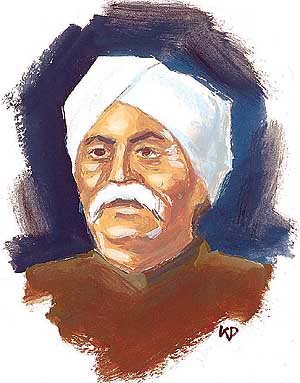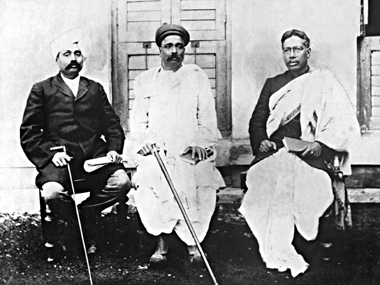<Back to Index>
- Philosopher Vladimir Sergeyevich Solovyov, 1853
- Writer Marta Bibescu (Marthe Lucie Lahovary), 1886
- Indian Freedom Fighter Lala Lajpat Rai, 1865
PAGE SPONSOR



Lala Lajpat Rai (1865 – 1928, Punjabi: ਲਾਲਾ ਲਜਪਤ ਰਾਯ, Urdu: لالا لجپت راے; Hindi: लाला लाजपत राय) was an Indian author, freedom fighter and politician who is chiefly remembered as a leader in the Indian fight for freedom from the British Raj. He was popularly known as Punjab Kesari (The Lion of Punjab) or Sher-e-Punjab meaning the same. He was also associated with activities of Punjab National Bank and Lakshmi Insurance Company in their early stages.
Lajpat Rai was born in an Agarwal family in Dhudike (now in Moga district, Punjab) on 28 January, in 1865. His grandfather was a Svetambara Jain while his father had great respect for Islam, and he even fasted and prayed like muslims, but did not embrace Islam largely due to his family's attachment to the Hindu faith. Lala Lajpat Rai had his initial education in Govt. Higher Secondary School, Rewari (now in Haryana, was earlier in Punjab), in the last 1870s and early 1880s where his father Radha Krishan was an Urdu teacher. Lala Lajpat Rai was influenced by Hinduism and Manusmriti and created a career of reforming Indian policy through politics and writing. (When studying law in Lahore, he continued to practice Hinduism. He became a large believer in the idea that Hinduism, above nationality, was the pivotal point upon which an Indian lifestyle must be based.) Hinduism, he believed, led to practices of peace to humanity, and the idea that when nationalist ideas were added to this peaceful belief system, a non-secular nation could be formed. His involvement with Hindu Mahasabhaite leaders gathered criticism from the Bharat Sabha as the Mahasabhas were anti - secularist, which did not conform with the system laid out by the Indian National Congress. This focus on Hindu practices in the subcontinent would ultimately lead him to the continuation of peaceful movements to create successful demonstrations for Indian independence.
In 1928, Lajpat Rai led a procession with Pandit Madan Mohan Malaviya to demonstrate against the Simon Commission. During this procession, Rai became the target of a lathi charge (a form of crowd control in which the police use heavy staves or `lathis' in Hindi) led by British police. During World War I, Lajpat Rai lived in the United States, but he returned to India in 1919 and in the following year led the special session of the Congress Party that launched the noncooperation movement. Imprisoned from 1921 to 1923, he was elected to the legislative assembly on his release. When the commission visited Lahore on 30 October 1928, Lala Lajpat Rai led the protest against the Simon Commission in a silent non-violent march, but the police responded with violence. Lala Lajpat Rai was beaten with lathis at the chest. He later succumbed to his injuries. Bhagat Singh, who was an eyewitness to this event, claimed that it was this act that caused him to 'vow to take revenge' against the culprits of this violence.
Rai traveled to the US in 1907, and then returned during World War I. He toured Sikh communities along the US West Coast; visited Tuskegee University in Alabama; and met with workers in the Philippines. His travelogue, The United States of America (1916), details these travels and features extensive quotations from leading African American intellectuals, including W.E.B. DuBois and Fredrick Douglass. The book also argues for the notion of “color - caste,” suggesting a sociological similarities between race in the US and caste in India. The term comes from sociological work done at Columbia University during the 1910s.
The Lala Lajpat Rai Trust was formed in 1959 on the eve of his Centenary Birth Celebration, to promote education. The trust was founded by a group of Punjabi philanthropists (including R.P Gupta and B.M Grover) who have settled and prospered in the Indian State of Maharashtra.
A
statue of Lajpat Rai stands at the central square in Shimla, India.
Lajpat Nagar and Lajpat Nagar Central Market in New Delhi, Lajpat Rai
Market in Chandani Chowk, Delhi. Lala Lajpat Rai Hall of Residence at Indian Institutes of Technology (IIT) in Kharagpur and Lala Lajpat Rai Institute of Engineering and Technology (LLRIET), Moga, are
named in his honor. Also many institutes, Schools and Library in his
hometown of Jagraon, district Ludhiana are named after him. The bus
terminus in Jagraon, Punjab, India, is named after Lala Lajpat Rai. Lala
Lajpat Rai Hospital, Kanpur, is also named in his honor. Lala
Lajpat Rai's mother, Gulab Devi, died of TB in Lahore. In order to
perpetuate her memory, Lala Lajpat Rai established a Trust in 1927 to
build and run a TB Hospital for women reportedly at the spot where she
had breathed her last. The
Trust purchased 40 acres of land in April 1930 from the then Government
which gave a free grant of an additional 10 acres on Ferozpur Road (now
Sharah - e - Roomi). Construction work was started in 1931 and completed in
1934 when the Hospital gates were opened to TB patients. A
marble plaque bears witness to the opening of the Hospital on 17 July
1934 by Mr. Mahatma Gandhi. On the migration of trustees to India in
1947, the Government invited Begum Raana Liaquat Ali Khan, Syed Maratab
Ali, Professor Dr.Amiruddin and some other notables and philanthropists
to become acting Trustees of the Hospital in July 1948.They constituted
a Managing Committee with Begum Raana in the Chair, for running the
Gulab Devi Chest Hospital.
